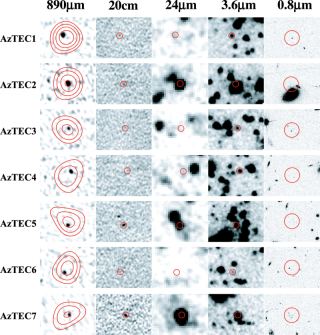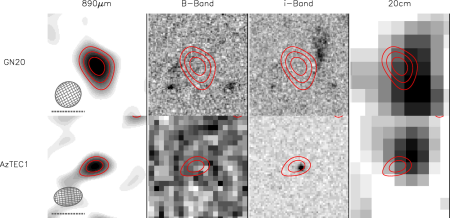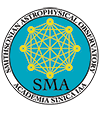 |
High-Redshift Submillimeter Galaxies
One of the most important advances in submillimeter (submm) astronomy in the 1990's was the discovery of submm-luminous galaxies (SMGs) at intermediate and high redshifts. These important observations gave insight into an otherwise invisible critical phase in the birth and evolution of galaxies and provided important constraints on theoretical models. These objects have been identified as luminous and ultra-luminous infrared (LIRGs and ULIRGs) and are thought to dominate the cosmic star formation rate (SFR) density at z > 1, drive the star formation of luminous quasars and are the most massive galaxies. At submm wavelengths the redshifted far-infrared peak emission of SMGs counteracts the effect of the decrease in luminosity due to distance to provide an unbiased view of obscured star formation out to z ~ 10. However, a complete understanding of these objects has been hindered by the relatively poor resolution of submm cameras (FWHM ~ 10 - 18 arcsec), which makes identification of multi-wavelength counterparts ambiguous. The association of radio sources with some SMGs has permitted their identification with multi-wavelength counterparts, and has shown that most of these galaxies lie at high-redshift (z ~ 2 - 3). However, due to the rapidly decreasing radio flux with increasing redshift, the sample is biased to lower redshifts (1 < z < 3).
Interferometric observations at millimeter and submm wavelengths provide a method of significantly increasing the precision of absolute position measurements (~ 1 - 2 arcsec) over single dish instruments and permit unambiguous identification of multi-wavelength counterparts. Using the SMA, combined with Spitzer Space Telescope observations with IRAC and MIPS, it was first discovered that the multi-wavelength counterparts of radio-dim submm galaxies provided evidence for a significant population of SMGs at higher redshift (z > 3) than the radio-selected sample (Younger et al. 2007). Follow-up spectroscopic observations of several of these objects have indicated their redshifts are at z ~ 4 - 5. It also appears that the highest redshift SMGs are the brightest SMGs. All of the SMGs in the SMA sample are unresolved in the compact configuration, yielding a maximum physical scale of < 8 - 9 kpc.
 |
Click here for larger view |
Figure 1: Stamp images for the SMA/AzTEC sources (top to bottom, AzTEC1-7) for (left to right) SMA (890 µm), VLA radio continuum (20 cm), MIPS channel 1 (24 µm), IRAC channel 1 (3.6 µm), and ACS (i band; 0.8 µm) imaging data. Overlaid in red on the SMA image are contours at 3σ, 4&sigma, ... from AzTEC imaging data (K. Scott et al. 2008, in preparation). The red circles in the remaining stamps have a radius 2", corresponding to twice the FWHM of the SMA beam, at the SMA position. Two sources (AzTEC 1 and 7) have secure optical counterparts in the ACS images, while AzTEC 3 and 6 have candidate optical counterparts that are a potential foreground object and outside the SMA beam, respectively. Each stamp image is 37" X 27", with the exception of the ACS stamps, which are 15" X 11". (Younger et al., 2007) |
Very high-resolution SMA imaging of two of the brightest high-redshift (z ~ 4) SMGs known, GN 20 and AzTEC 1 at 0.8 and 0.3 arcsec resolution, respectively, indicates that their angular extent corresponds to physical scales of 4 - 8 and 1.5 - 3 kpc, respectively, for the starburst region (Younger et al. 2008). These objects have star formation rates > 1000 M⊙/yr and are radiating at or close to their Eddington limit. Theoretical models struggle to account for such a population of high-redshift ultraluminous starburst galaxies. The most cited SMA papers in extragalactic research have been in the area of high-z SMGs.
 |
Click here for larger view |
Figure 2: Stamp images, 3" on a side, of GN 20 (top) and AzTEC1 (bottom). From left to right: SMA 890 µm dirty map using EXT configuration data; B-band imaging (HST ACS for GN 20, ground-based Subaru for AzTEC1); i-band HST ACS imaging; and VLA 20 cm imaging data. The contours overlaid on all frames are from the SMA EXT configuration dirty map, in intervals of 3, 5, 7... times the rms noise. For reference, the gray dashed line is 1" in length, and the beam is indicated for each with a hashed gray ellipse: 0.81" x 0.75" and 0.86" x 0.55" FWHM for GN 20 and AzTEC1, respectively. (Younger et al., 2008) |
» Next Page: Extragalactic H20 Masers/eSMA
« Previous Page
SMA Research
| |
| |



